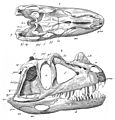Ceratosaurus facts for kids
Quick facts for kids CeratosaurusTemporal range: Upper Jurassic
|
|
|---|---|
 |
|
| Scientific classification | |
| Kingdom: | |
| Phylum: | |
| Class: | |
| Superorder: | |
| Order: | |
| Suborder: | |
| Infraorder: | |
| Family: | |
| Genus: |
†Ceratosaurus
|
Ceratosaurus was a meat-eating dinosaur that lived a very long time ago. It roamed the Earth during the Upper Jurassic period, about 156 to 145 million years ago. This amazing dinosaur is known for its unique look. It had a large horn right on its nose! It also had two smaller horns just in front of its eyes.
What made Ceratosaurus even more special was its armor. Unlike many other large meat-eating dinosaurs called theropods, Ceratosaurus had small bony plates. These plates, called osteoderms, ran down the middle of its back, giving it extra protection.
| Top - 0-9 A B C D E F G H I J K L M N O P Q R S T U V W X Y Z |
What Ceratosaurus Ate
Ceratosaurus shared its home with many other famous dinosaurs. These included plant-eaters like Apatosaurus, Diplodocus, Stegosaurus, and Camarasaurus. It also lived alongside other big predators such as Allosaurus and Torvosaurus.
Size and Hunting Style
Ceratosaurus could grow to about 6.7 meters (22 feet) long. It weighed up to 980 kilograms (2,160 pounds). This made it smaller than some of the other huge meat-eaters of its time. Scientists think Ceratosaurus had a different hunting style than its larger cousins.
Its body was longer and more flexible. It also had a deep tail, much like a crocodilian's. This suggests that Ceratosaurus might have been a better swimmer than the stiffer Allosaurus. Some experts believe Ceratosaurus often hunted animals that lived in water. This could include fish and crocodiles. However, its teeth were strong enough to eat large dinosaurs too.
Sharing the Land
Ceratosaurus, Allosaurus, and Torvosaurus likely had different ways of living. This helped them avoid competing for the same food. Ceratosaurus and Torvosaurus might have preferred areas near water. Their lower, thinner bodies would have helped them move through forests and thick bushes.
Allosaurus, on the other hand, had longer legs and was built for speed. It probably preferred open, dry areas. Ceratosaurus also had a taller, narrower skull. Its teeth were very large and broad. This was different from Allosaurus. Sometimes, bigger predators like Allosaurus might even become food for others. Scientists have found Allosaurus bones with tooth marks. These marks were likely made by a Ceratosaurus or Torvosaurus that was scavenging.
The Mystery of the Nasal Horn
When Ceratosaurus was first discovered, scientists wondered about its big nose horn. Some early researchers thought it was a powerful weapon. They believed it was used for both attacking and defending itself.
However, most scientists today think this is unlikely. They believe the horn was probably not for fighting other predators. Instead, it might have been used for showing off! Male Ceratosaurus might have used their horns to impress females. They could have also used them to challenge other males for breeding rights.
Imagine two Ceratosaurus pushing their horns together in a friendly contest. This would be like a display, not a deadly fight. If the horn was for showing off, it might have even been brightly colored. This would make it stand out even more!
Images for kids
-
C. nasicornis skeleton restoration by Othniel Charles Marsh from 1896, depicted in an erroneous upright position and with excess vertebrae in the spine resulting in an overly elongated trunk
-
Restoration of C. nasicornis by Joseph M. Gleeson from 1901, made under supervision of Charles R. Knight.
-
Distinguishing skull features of Ceratosaurus: The fused left and right nasal bones form a prominent nasal horn (top), and the teeth of the upper jaw are exceptionally long (bottom). These fossils are part of specimen MWC 1 from Fruita, Colorado, and are on display at the local Dinosaur Journey Museum.
-
C. nasicornis holotype, as mounted by Charles Gilmore in 1910 and 1911, National Museum of Natural History
-
Mounted cast of a juvenile skeleton, Dinosaur Discovery Museum
-
Dry season at the Mygatt-Moore Quarry showing Ceratosaurus (center) and Allosaurus fighting over the desiccated carcass of another theropod
See also
 In Spanish: Ceratosaurus para niños
In Spanish: Ceratosaurus para niños
















